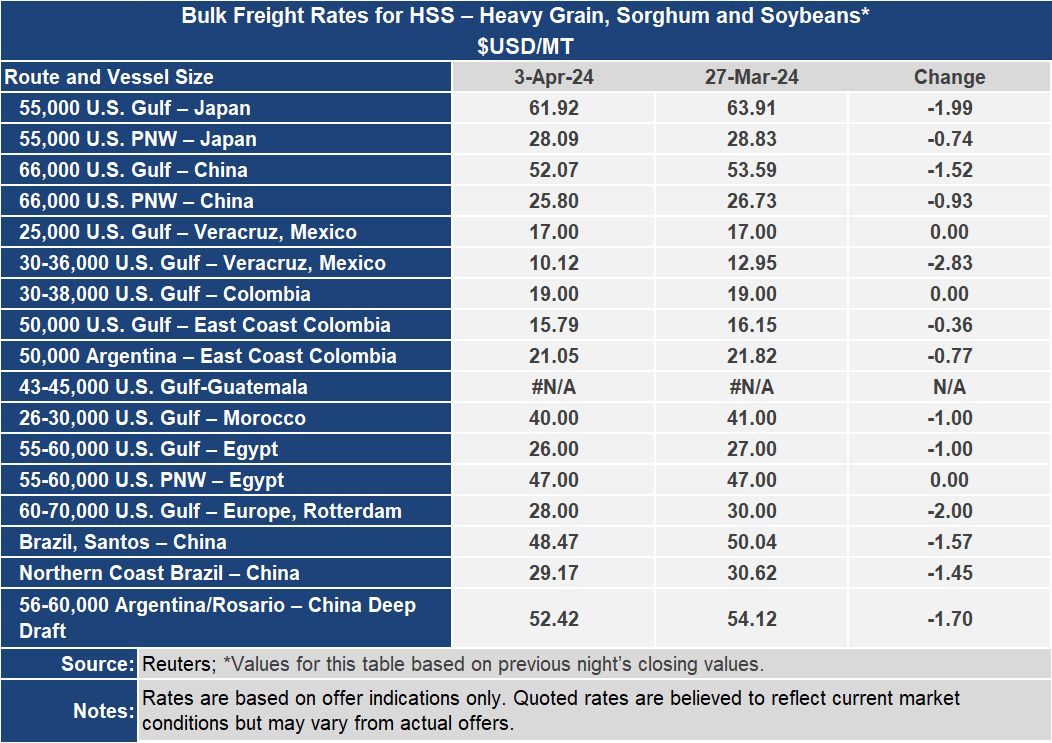Ocean Freight Markets and Spreads

Ocean Freight Comments
Access to the Port of Baltimore is limited following last week’s collision of the MV Dali with the Francis Scott Key Bridge, causing it to collapse. The U.S. Army Corps of Engineers in coordination with the U.S. Coast Guard and industry participants secured a temporary channel with a controlling depth of 11 feet (3.35 meters) on the northbound side of the wreckage. The first vessel to transit the channel was a tugboat pushing a barge supplying jet fuel to the U.S. Department of Defense. A second temporary channel on the southbound side with a depth of 15 to 16 feet (4.6 to 4.9 meters) would open “in the coming days.” Once debris is cleared, a third channel with a depth of 20 to 25 feet (6.1 to 7.6 meters) would allow almost all tug and barge traffic in and out of the port. However, most ocean-going vessels accessing the Port of Baltimore require 35 to 45 feet (10.7 to 13.7 meters) of draft. Until the MV Dali and portions of the bridge in the main navigation channel are removed, access to and from the Port of Baltimore will be limited for several weeks if not months.
The Houthis attacks on vessels using the Red Sea have slowed in recent weeks. Some of the slowness might be in observation of Ramadan that started on March 10 and ends April 8. But the United States and United Kingdom militaries continue to keep a firm stand against the Houthis. As of the end of March, U.S., U.K. and coalition forces destroyed, or tracked the firing, or the intent to launch, of at least 30 anti-ship ballistic missiles, six anti-ship cruise missiles, 10 surface drones, 72 air drones, one underwater drone, six weapon storage containers and 41 other surface-to-air and anti-ship missiles.
Water levels of Panama’s Gatun Lake are essentially unchanged for three weeks, though they are expected to drop slightly over the next month. By the end of May and early June, replenishing the water level are anticipated once the rainy season gets underway. Despite the positive implications, it will take several months of steady rain to restore water levels to normal levels. Historically, the month of May is the lowest levels for Gatun Lake. Gatun Lake is a reservoir for water used to lock vessels across the isthmus between the Atlantic and Pacific Oceans.
The slide in ocean freight rates persists with the Baltic Dry Index dropping 7% this week to 1,711, which is the lowest level since February 21 this year. The index fell as the Capesize market was down nearly 8% for the week to an index of 2,437 while the Panamax sector was down about 9% to 1,772. The Baltic Supramax Index dropped 5% to 1,284. Despite the Port of Baltimore being shut off from the world, economic forces elsewhere are inflicting greater wounds to demand for vessel capacity. There have been no reports of significant damage to Taiwan’s ports since the largest earthquake hit there in one quarter of a century.
Voyage freight rates for grain shipments out of the U.S. Gulf to Japan were down 3% or $1.99 per metric ton for the current week to $61.92 per metric ton. Out of the Pacific Northwest the rate to Japan was down nearly 3% or $0.74 per metric ton to $28.09 per metric ton. The spread between these key routes narrowed by about 4% or $1.25 per metric ton to $33.83 per metric ton. Of note is the rate from the U.S. Gulf to Veracruz, Mexico that dropped 22% or $2.83 per metric ton this week to $10.12 per metric ton on a Supramax vessel.



